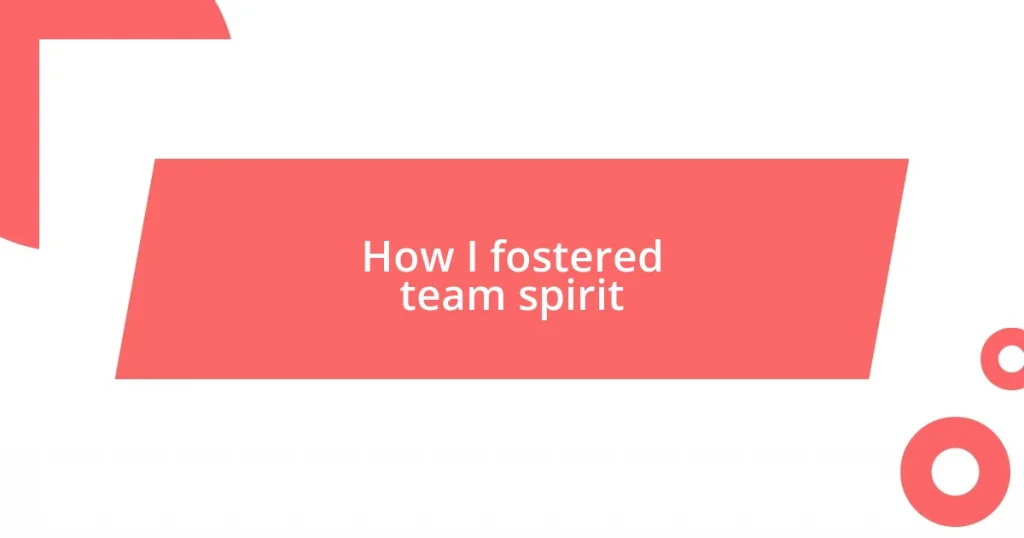Key takeaways:
- Fostering team spirit enhances collaboration, resilience, and motivation among team members.
- Recognizing individual strengths and creating open communication channels significantly improve team dynamics and trust.
- Organizing team-building activities and celebrating contributions strengthens relationships and sustains team momentum.

Understanding team spirit importance
Understanding the importance of team spirit is crucial for any group aiming for success. In my experience, when everyone feels connected, collaboration naturally flourishes. Have you ever felt the energy shift in a room when a team rallies together? It’s palpable and can ignite creativity and motivation.
I recall a time when my team faced a particularly tough project deadline. Instead of succumbing to stress, we leaned on each other for support. In those moments, I realized that team spirit doesn’t just help with workload; it fosters a sense of belonging. Doesn’t it feel good to know that you have people behind you, cheering for your success?
Moreover, a strong team spirit cultivates resilience. I’ve witnessed teams crumble under pressure, often due to a lack of trust and cohesion. Conversely, teams that support one another are better equipped to navigate challenges. Isn’t it fascinating how trust can transform a group from just coworkers into a united front?
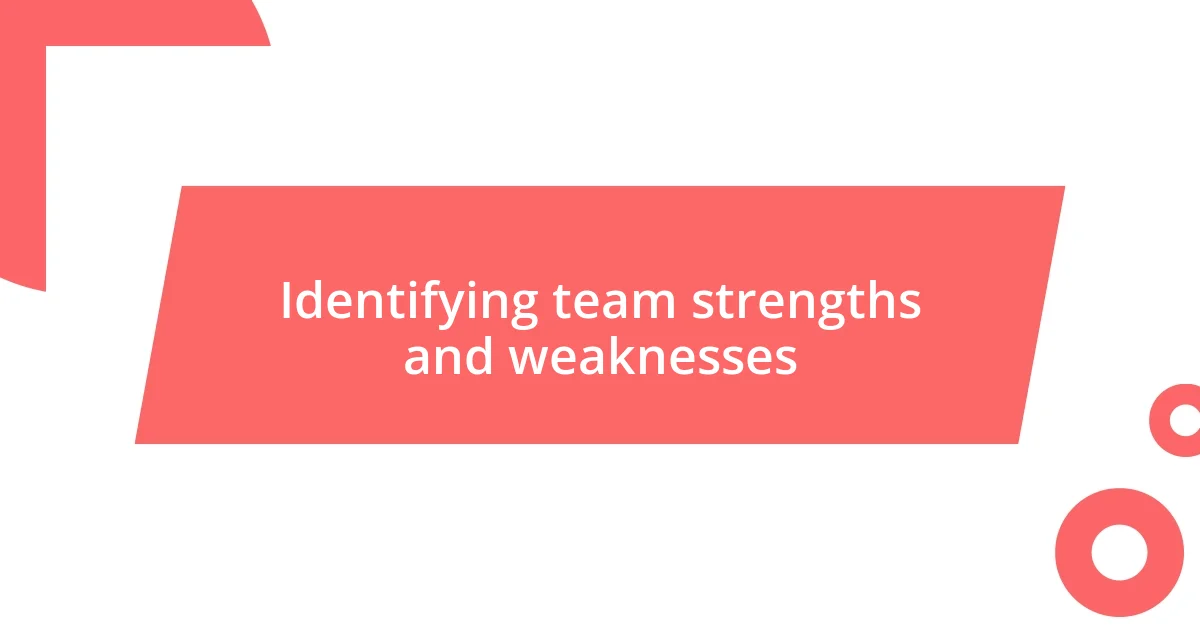
Identifying team strengths and weaknesses
Recognizing the strengths and weaknesses within a team is a pivotal step toward fostering a cohesive spirit. In my journey, I’ve often discovered that acknowledging what each member excels at boosts confidence and productivity. For instance, I once highlighted a team member’s exceptional analytical skills in a meeting, which not only made them shine but also encouraged others to share their unique contributions. This practice of spotlighting individual talents nurtured an environment of mutual respect and motivation.
- Strengths: Clear communication, diverse skill sets, collaboration, innovative problem-solving.
- Weaknesses: Lack of adequate feedback, avoidance of accountability, unclear roles, difficulty adapting to changes.
When I conducted team assessments, it became apparent that we had a tendency to overlook areas needing improvement. A straightforward feedback session revealed some unspoken frustrations, ultimately leading to solutions that aligned with our goals. I realized then that it takes courage to admit weaknesses, but doing so opens the door to growth and deeper connections. Haven’t you noticed how vulnerability can bring a team closer together?
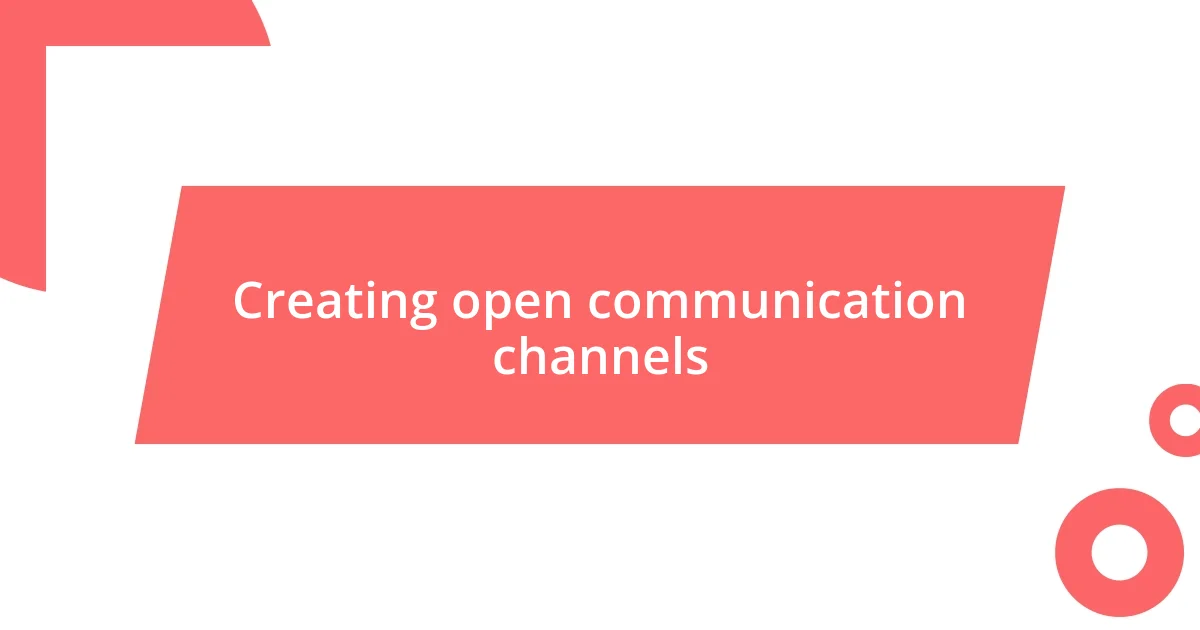
Creating open communication channels
Creating open communication channels is fundamental in nurturing a strong team spirit. I’ve found that when team members feel safe to express their thoughts and concerns, it fosters an environment of trust. In one of my past projects, I implemented a weekly check-in where everyone could voice their ideas without fear of judgment. Interestingly, the level of engagement skyrocketed; it became a space of camaraderie and innovation.
Additionally, actively encouraging feedback among team members can significantly enhance open communication. Once, during a brainstorming session, I invited each person to share their perspective on a project direction. This not only generated diverse ideas but also made everyone feel like an integral part of the journey. The emotional lift in the room was palpable; the simple act of listening established deeper connections and fueled our motivation.
The use of modern communication tools can further bridge gaps and streamline interactions. For instance, when we switched to a collaborative platform, I noticed that team members began exchanging thoughts more freely, even outside formal meetings. This newfound accessibility made our dynamics richer and more engaging, illustrating how technology can complement personal relationships effectively.
| Communication Method | Effectiveness |
|---|---|
| Weekly Check-Ins | High – Encourages open dialogue and builds trust |
| Feedback Sessions | Very High – Gathers diverse ideas and opinions |
| Collaborative Tools | High – Streamlines interactions, making communication more accessible |
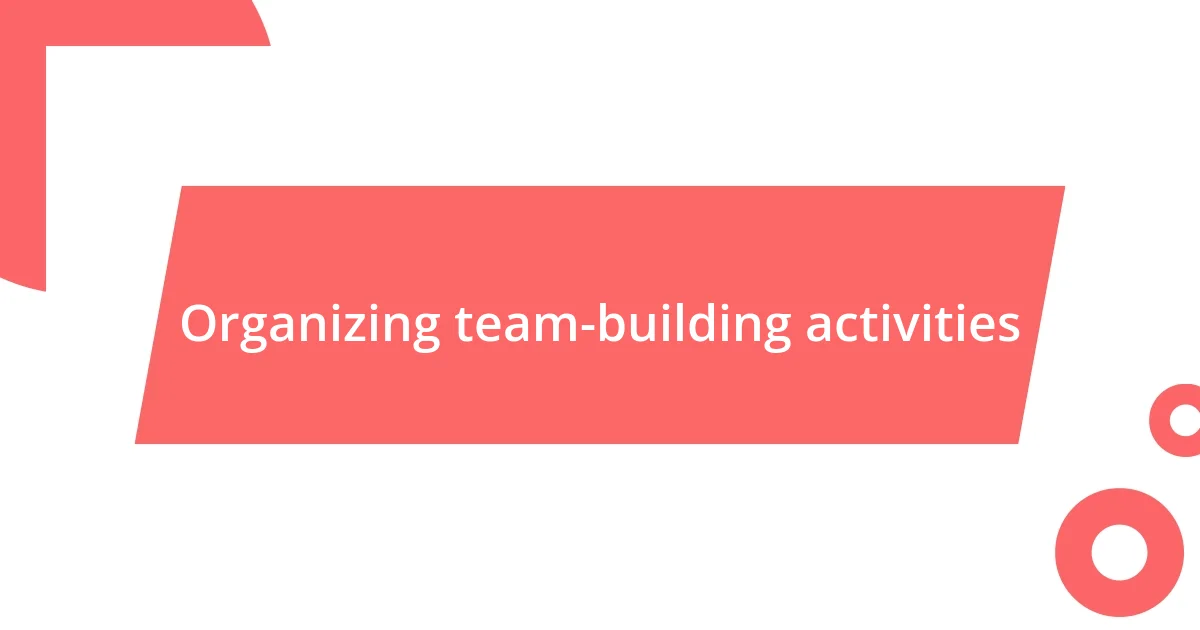
Organizing team-building activities
Organizing team-building activities is a fantastic way to enhance camaraderie among team members. I vividly recall a team retreat we organized, filled with fun challenges that pushed us out of our comfort zones. We engaged in everything from trust falls to obstacle courses, and it was amazing to see how these playful tasks brought us closer and revealed hidden strengths in every individual. Have you ever experienced that magical moment when laughter dissolves barriers and transforms colleagues into friends?
One of the most meaningful activities I organized was a volunteer day at a local charity. We spent the day working side by side, and it was heartwarming to witness the sense of purpose and unity that emerged. It wasn’t just about completing a task; we were building memories that fostered deeper connections. I learned that shared experiences outside of work can significantly enhance not only teamwork but also personal bonds. Isn’t it intriguing how giving back together creates a unique spirit amongst a group?
Incorporating fun elements into team-building brings out creative energy, making the workplace a more vibrant environment. When we introduced a game night, where team members shared their favorite games, it sparked joy and led to unexpected collaborations. Those interactions showed me that sometimes, the best ideas spring from laughter and casual conversations. Have you noticed how informal settings can lead to breakthroughs that meetings often miss?
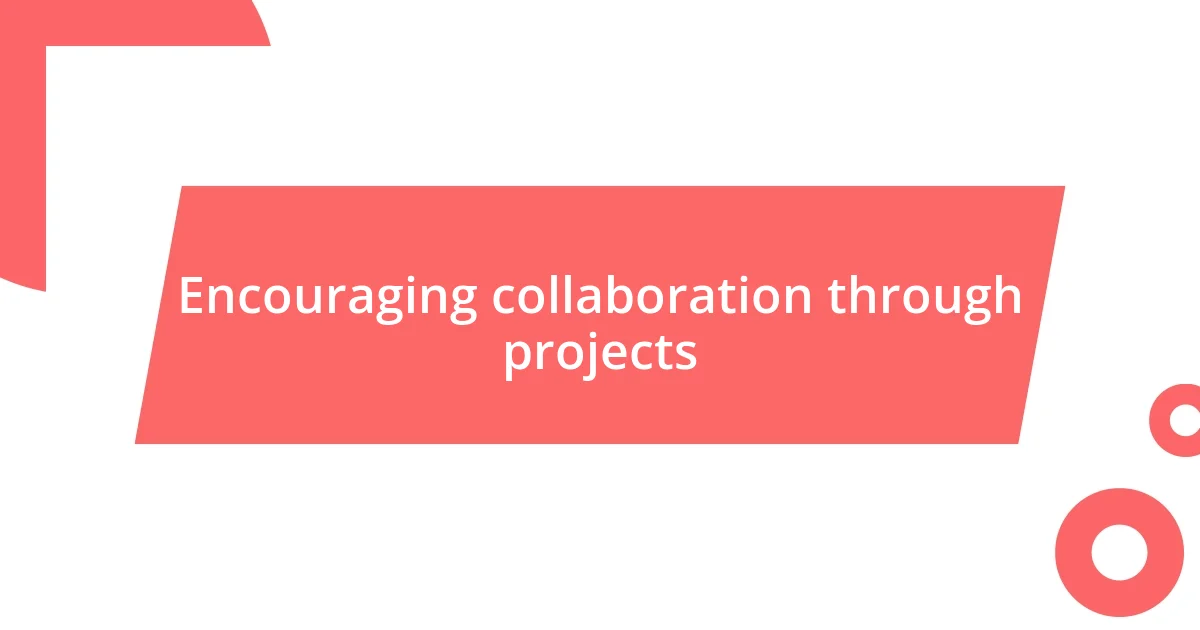
Encouraging collaboration through projects
Encouraging collaboration through projects is often about creating shared experiences that resonate with everyone involved. I remember a particular project where we divided the team into smaller groups, each tasked with a specific aspect of our goal. This allowed individuals to bring their unique skills to the table while working towards a common objective. Watching them exchange ideas and learn from one another was an eye-opener; it showed me how collaboration could spark creativity and innovation.
In another instance, I introduced a system where team members could take turns leading project meetings. This not only empowered them but also encouraged a sense of ownership and accountability in our projects. One team member, who initially expressed reluctance, surprised us all with a brilliant approach that changed the project’s direction for the better. Isn’t it fascinating how giving people the opportunity to step up can unlock their potential?
Moreover, I always aimed to celebrate our milestones together, no matter how small. After completing a challenging phase of a project, I suggested a casual lunch to reflect on our journey. This simple act strengthened our bond and reminded us of our collective achievement. Have you ever noticed how celebrating successes—big or small—can build a solid foundation for collaboration? It’s those moments of recognition that truly enhance team spirit.
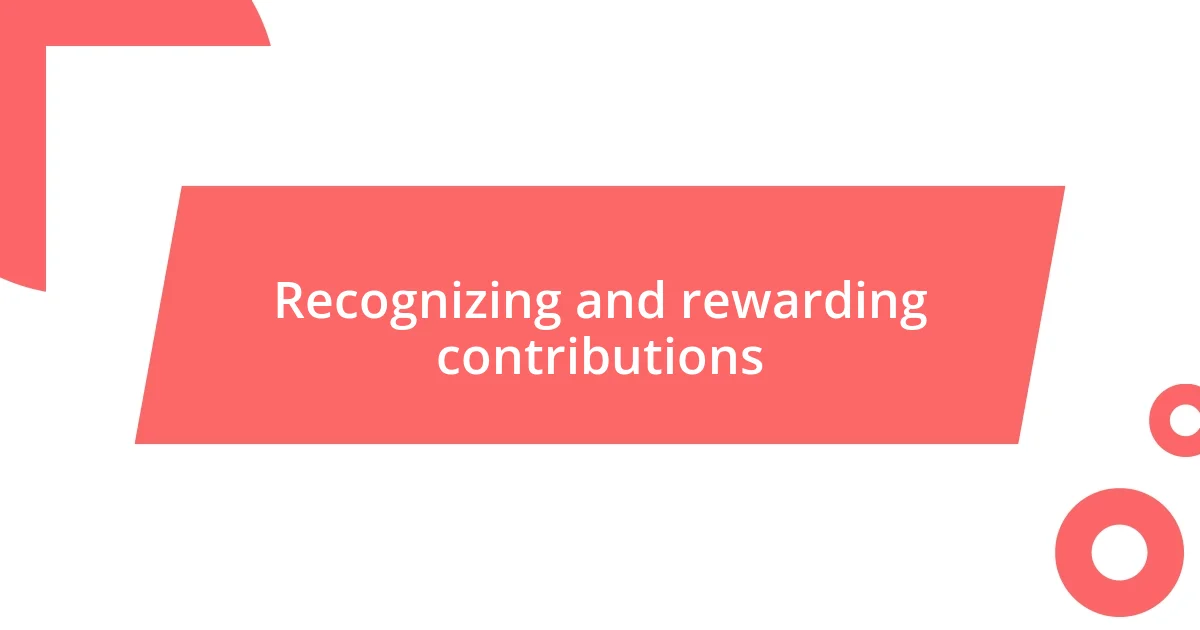
Recognizing and rewarding contributions
Recognizing contributions within a team is like nurturing a garden; it requires attention and care. I remember a time when we launched a “Kudos Board” in our workspace. Every week, team members would jot down a note of appreciation for someone else’s efforts. The amazing part? The gratitude blossomed organically, creating a culture where everyone felt valued. Isn’t it beautiful how simple recognition can uplift someone’s entire day and promote a sense of belonging?
To further solidify this recognition, I once pitched the idea of “Spotlight Awards” at our monthly meetings. Each month, we would highlight a team member’s achievements—big or small—which really helped in building enthusiasm. During one meeting, when a colleague saw her name on the slide and the applause that followed, I could literally see her confidence grow. Have you ever noticed how a little acknowledgment can not only affirm our efforts but also inspire us to reach for greater heights?
Additionally, integrating rewards, whether it’s through gift cards or extra time off, serves as a fantastic motivator. I distinctly remember a project where we achieved our goals ahead of schedule. We decided to treat the entire team to a fun outing, which turned into a celebration of our hard work. That experience reminded me that recognizing contributions not only reinforces individual value but also strengthens the entire team’s spirit. Have you ever thought about how rewarding achievements creates a ripple effect of motivation within a group?
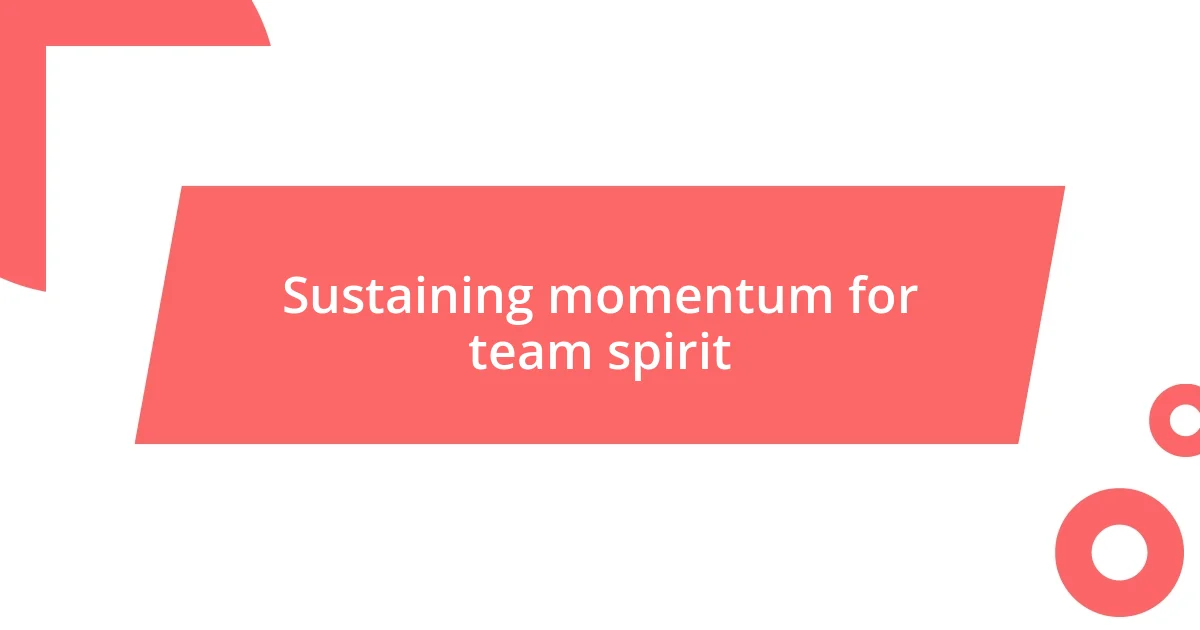
Sustaining momentum for team spirit
Sustaining momentum for team spirit often requires consistent effort and a genuine connection among team members. I recall initiating bi-weekly check-ins, where we would gather not just to discuss projects but to share personal wins and challenges. One day, a teammate opened up about a family issue, and the support that followed reinforced the trust within our group. Have you ever experienced that moment when vulnerability invites deeper relationships? It’s those simple yet profound exchanges that can keep the momentum alive.
Another effective strategy I employed was integrating friendly competitions into our routine. For instance, we launched a monthly ‘team challenge’ that could be anything from a fitness goal to creative brainstorming sessions. I was amazed at how a little competition could spark excitement and camaraderie. When one of our quieter team members proposed a unique idea during a challenge, it reminded me that everyone has something valuable to contribute. Don’t you think that fostering such an environment can encourage shy members to find their voice?
Lastly, I always made it a point to keep the communication channels open. Whether it was through casual coffee chats or team-wide updates, sharing insights about our progress and goals was vital. During a particularly taxing project, I kept the team informed about not just the successes but also the hurdles we faced. This transparency helped maintain our collective energy; everyone felt they were part of the journey. Have you noticed how open dialogue can create a sense of unity? It truly makes a difference in sustaining that enthusiastic team spirit we all strive for.










